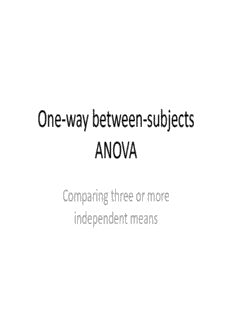
One-way between-subjects ANOVA PDF
Preview One-way between-subjects ANOVA
One-way between-subjects ANOVA Comparing three or more independent means ANOVA: A Framework • Understand the basic principles of ANOVA – Why it is done? – What it tells us? • Theory of one-way between-subjects ANOVA • Following up an ANOVA: – Planned Contrasts/Comparisons • Choosing Contrasts • Coding Contrasts – Post Hoc Tests • Writing up Results Why ANOVA? • t tests are limited to situations in which there are only two levels of a single independent variable or two associated groups. • There are many instances in which we’d like to compare more than two levels. But … performing multiple t tests can inflate the Type I error rate. One-Way ANOVA • The one-way analysis of variance is used to test the null hypothesis that three or more population means are equal – more precisely: test the null hypothesis that the means of the groups are not significantly different from the grand mean of all participants One-Way ANOVA • The response variable is the variable you’re comparing, i.e., dependent variable • The factor variable is the categorical variable being used to define the groups, i.e., independent variable – Usually called k samples (groups) • The one-way is because there is one independent variable Assumptions • Scale dependent variable • Normal distribution • Equal variances The basic principle behind ANOVA Produces a test statistic termed the F-ratio Systematic Variance Unsystematic Variance If the model explains a lot more variability than it can’t explain, then the experimental manipulation has had a significant effect on the outcome (DV). e c Basis n for SS a R i Basis r for a X = 5.00 SS HighDose T V Grand Mean = e 3.467 Basis for h SS X = 3.20 M LowDose t g X = 2.20 Placebo n i n o i t i t r SS = differences SS = based on SS = based on M R T a between predicted values differences between differences between (group means) and the person’s score and each data point and P grand mean their group mean. the grand mean Partitioning the variance • SS = differences between predicted values (group M means) and the grand mean (i.e., variation across groups) – if there is a significant difference between the groups, this should be a large number relative to SS R • SS = based on differences between person’s score and R their group mean (i.e., variation with each group) • SS = based on differences between each data point and T the grand mean (the total variation in the entire data set) Mean Squares (MS and MS ) M R SS = amount of variation explained by the model (exp. manipulation). M SS = amount of variation due to extraneous factors. R These are “summed” scores and will therefore be influenced by the number of scores. To eliminate this bias we calculate the average sum of squares (mean squares) by dividing by the appropriate degrees of freedom. Calculating Degrees of Freedom (for one-way independent groups ANOVA) df = N - 1 (number of all scores minus 1) total df = k - 1 (number of groups minus 1) M / between df = N - k (number of all scores minus number of groups) R / within
Description: